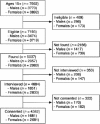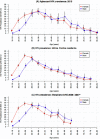Prevalence of HIV among those 15 and older in rural South Africa
- PMID: 23311396
- PMCID: PMC3778517
- DOI: 10.1080/09540121.2012.750710
Prevalence of HIV among those 15 and older in rural South Africa
Abstract
A greater knowledge of the burden of HIV in rural areas of Southern Africa is needed, especially among older adults. We conducted a cross-sectional biomarker survey in the rural South African Agincourt Health and Socio-demographic Surveillance site in 2010-2011 and estimated HIV prevalence and risk factors. Using an age-sex stratified random sample of ages 15+, a total of 5037 (65.7%) of a possible 7662 individuals were located and 4362 (86.6%) consented to HIV testing. HIV prevalence was high (19.4%) and characterized by a large gender gap (10.6% for men and 23.9% for women). Rates peaked at 45.3% among men and 46.1% among women - both at ages 35-39. Compared with a similar study in the rural KwaZulu-Natal Province, South Africa, peak prevalence occurred at later ages, and HIV prevalence was higher among older adults - with rates above 15% for men and 10% for women through to age 70. High prevalence continues to characterize Southern Africa, and recent evidence confirms that older adults cannot be excluded from policy considerations. The high prevalence among older adults suggests likely HIV infection at older ages. Prevention activities need to expand to older adults to reduce new infections. Treatment will be complicated by increased risk of noncommunicable diseases and by increasing numbers of older people living with HIV.
Figures




References
-
- Central Statistical Office (CSO) [Swaziland] and Macro International. Swaziland demographic and health survey 2006–07. Calverton, MD: Author; 2008.
-
- Levitt N. S., Steyn K., Dave J., Bradshaw D. Chronic noncommunicable diseases and HIV-AIDS on a collision course: Relevance for health care delivery, particularly in low-resource settings – insights from South Africa. The American Journal of Clinical Nutrition. 2011;94(6):1690S–1696S. - PMC - PubMed
-
- Mills E. J., Rammohan A., Awofeso N. Ageing faster with AIDS in Africa. The Lancet. 2010;377(9772):1131–1133. - PubMed
Publication types
MeSH terms
Grants and funding
LinkOut - more resources
Full Text Sources
Other Literature Sources
Medical
Miscellaneous
